
Camouflage is the use of any combination of materials, coloration, or illumination for concealment, either by making animals or objects hard to see, or by disguising them as something else. Examples include the leopard's spotted coat, the battledress of a modern soldier, and the leaf-mimic katydid's wings. A third approach, motion dazzle, confuses the observer with a conspicuous pattern, making the object visible but momentarily harder to locate. The majority of camouflage methods aim for crypsis, often through a general resemblance to the background, high contrast disruptive coloration, eliminating shadow, and countershading. In the open ocean, where there is no background, the principal methods of camouflage are transparency, silvering, and countershading, while the ability to produce light is among other things used for counter-illumination on the undersides of cephalopods such as squid. Some animals, such as chameleons and octopuses, are capable of actively changing their skin pattern and colours, whether for camouflage or for signalling. It is possible that some plants use camouflage to evade being eaten by herbivores.

Flecktarn is a family of 3-, 4-, 5- or 6-color disruptive camouflage patterns, the most common being the five-color pattern, consisting of dark green, light green, black, red brown and green brown or tan depending on the manufacturer. The original German 5-color pattern was designed for use in European temperate woodland terrain. A 3-color variation called Tropentarn is intended for arid and desert conditions; the German Bundeswehr wore it in Afghanistan.

Dazzle camouflage, also known as razzle dazzle or dazzle painting, was a family of ship camouflage used extensively in World War I, and to a lesser extent in World War II and afterwards. Credited to the British marine artist Norman Wilkinson, though with a rejected prior claim by the zoologist John Graham Kerr, it consisted of complex patterns of geometric shapes in contrasting colours, interrupting and intersecting each other.

A combat uniform, field uniform, battledress or military fatigues, is a casual type of uniform used by military, police, fire and other public uniformed services for everyday fieldwork and combat duty purposes, as opposed to dress uniforms worn in functions and parades. It generally consists of a jacket, trousers and shirt or T-shirt, all cut more loose and comfortable than more formal uniforms. Design may depend on regiment or service branch, e.g. army, navy, air force, marines, etc. In the army branches, fabrics tend to come in camouflage, disruptive pattern or else green, brown or khaki monochrome, in order to approximate the background and make the soldier less visible in nature. In Western dress codes, field uniform is considered equivalent to civilian casual wear. As such, field uniform is considered less formal than service dress uniform, generally aimed at office or staff use, as well as mess dress uniform, and full dress uniform.

Military camouflage is the use of camouflage by an armed force to protect personnel and equipment from observation by enemy forces. In practice, this means applying colour and materials to military equipment of all kinds, including vehicles, ships, aircraft, gun positions and battledress, either to conceal it from observation (crypsis), or to make it appear as something else (mimicry). The French slang word camouflage came into common English usage during World War I when the concept of visual deception developed into an essential part of modern military tactics. In that war, long-range artillery and observation from the air combined to expand the field of fire, and camouflage was widely used to decrease the danger of being targeted or to enable surprise. As such, military camouflage is a form of military deception.

M90 camouflage is the camouflage pattern for the uniform system 90, used by the Swedish Armed Forces. The pattern consists of hard lined geometric shapes, aiming to create a camouflage pattern effective in the temperate forests and plains of Sweden. It is affectionately known among Swedish soldiers as lövhögen, or "the leaf pile." In addition to the standard pattern, which was designed with Swedish forests in mind, desert and jungle variants were later developed for international missions.
The Swedish Armed Forces have an extensive history, during which it has undergone changes in both the equipment and military uniforms it uses.
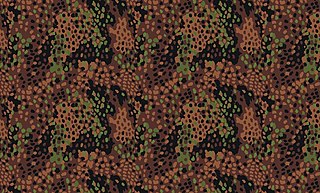
The Erbsenmuster or pea pattern was one of a family of German World War II camouflage patterns, said to have been designed by Johann Georg Otto Schick, and first issued to the Waffen-SS in 1944. The pattern had five colours, pale brown, dark brown, green, olive green and black, arranged as small rounded areas dotted over large irregular areas.

The following is a general overview of the Heer main uniforms, used by the German army prior to and during World War II.

Splittertarnmuster, Splittertarn or Splittermuster (splinter-pattern) is a four-colour military camouflage pattern developed by Germany in the late 1920s, first issued to the Reichswehr in 1931.

Ship camouflage is a form of military deception in which a ship is painted in one or more colors in order to obscure or confuse an enemy's visual observation. Several types of marine camouflage have been used or prototyped: blending or crypsis, in which a paint scheme attempts to hide a ship from view; deception, in which a ship is made to look smaller or, as with the Q-ships, to mimic merchantmen; and dazzle, a chaotic paint scheme which tries to confuse any estimate of distance, direction, or heading. Counterillumination, to hide a darkened ship against the slightly brighter night sky, was trialled by the Royal Canadian Navy in diffused lighting camouflage.

Aircraft camouflage is the use of camouflage on military aircraft to make them more difficult to see, whether on the ground or in the air. Given the possible backgrounds and lighting conditions, no single scheme works in every situation. A common approach has been a form of countershading, the aircraft being painted in a disruptive pattern of ground colours such as green and brown above, sky colours below. For faster and higher-flying aircraft, sky colours have sometimes been used all over, while helicopters and fixed-wing aircraft used close to the ground are often painted entirely in ground camouflage. Aircraft flying by night have often been painted black, but this actually made them appear darker than the night sky, leading to paler night camouflage schemes. There are trade-offs between camouflage and aircraft recognition markings, and between camouflage and weight. Accordingly, visible light camouflage has been dispensed with when air superiority was not threatened or when no significant aerial opposition was anticipated.
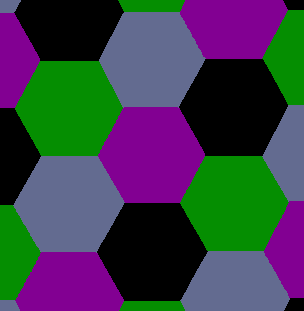
Lozenge camouflage was a military camouflage scheme in the form of patterned cloth or painted designs used by some aircraft of the Central Powers in the last two years of World War I, primarily those of the Imperial German Luftstreitkräfte. It takes its name from the repeated polygon shapes incorporated in the designs, many of which resembled lozenges. In Germany it was called Buntfarbenaufdruck but this designation includes other camouflage designs such as Splittermuster and Leibermuster, and does not include hand-painted camouflage.
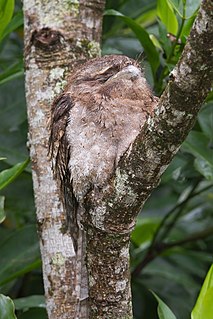
Disruptive coloration is a form of camouflage that works by breaking up the outlines of an animal, soldier or military vehicle with a strongly contrasting pattern. It is often combined with other methods of crypsis including background colour matching and countershading; special cases are coincident disruptive coloration and the disruptive eye mask seen in some fishes, amphibians, and reptiles. It appears paradoxical as a way of not being seen, since disruption of outlines depends on high contrast, so the patches of colour are themselves conspicuous.
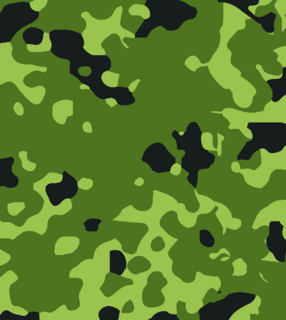
The M/84 camouflage pattern, is the former camouflage pattern of the Danish military. The M/84 is a derivative of the Flecktarn B pattern produced by the German firm Marquardt & Schulz. Using the same shapes and pattern, the number of colours was changed from 5 to 3 – choosing olive green, light green and black to better match the colouration of the Danish woodland environment.

German World War II camouflage patterns formed a family of disruptively patterned military camouflage designs for clothing, used and in the main designed during the Second World War. The first pattern, Splittertarnmuster, was designed in 1931 and was initially intended for Zeltbahn shelter halves. The clothing patterns developed from it combined a pattern of interlocking irregular green, brown, and buff polygons with vertical "rain" streaks. Later patterns, all said to have been designed for the Waffen-SS by Johan Georg Otto Schick, evolved into more leaf-like forms with rounded dots or irregular shapes. Camouflage smocks were designed to be reversible, providing camouflage for two seasons, whether summer and autumn, or summer and winter (snow). Distribution was limited to the Waffen-SS, ostensibly because of a patent, though variants were used by other units, including the Luftwaffe. Production was limited by shortage of materials, especially of high quality waterproof cotton duck.

Snow camouflage is the use of a coloration or pattern for effective camouflage in winter, often combined with a different summer camouflage. Summer patterns are typically disruptively patterned combinations of shades of browns and greys, up to black, while winter patterns are dominated by white to match snowy landscapes.

The TAZ 83 is a military camouflage pattern used by the Swiss Army for the Kampfanzug 57/70 and the TAZ 83. It also is known as "Alpenflage" or "pizza camouflage" among collectors of militaria as military surplus camouflage clothing it came on to the army surplus market in the 1990s.

The Netherlands Fractal Pattern was developed as a collaboration project between the Netherlands Organisation for Applied Scientific Research (TNO) and the Dutch Ministry of Defence in order to replace all the camouflage patterns in use by the Dutch military.
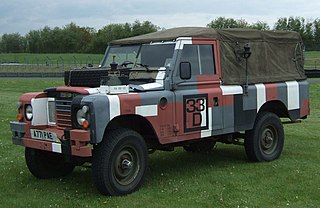
Urban camouflage is the use of camouflage patterns chosen to make soldiers and equipment harder to see in built-up areas, places such as cities and industrial parks, during urban warfare.





















